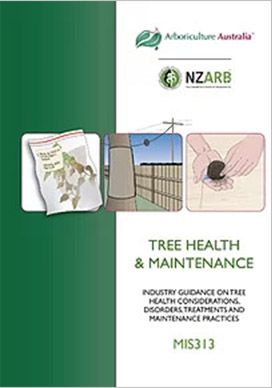
MIS313 Tree Health and Maintenance
MIS310 Tree Health and Maintenance
Minimum Industry Standard series Members Price is for Members of The New Zealand Arboricultural Association (NZARB). The vision of NZ Arb is to represent the arboriculture community and make it the primary organisation for tree care and to maintain relevancy to the Association’s members, so if you are in the NZ tree care industry please consider joining NZARB by clicking the link above if you are not already a member. |
This book is one in a series of Minimum Industry Standards produced by Arboriculture Australia Ltd in consultation with the national industry community. These peer-reviewed documents explain the core standards of skills and equipment with which practitioners should be familiar.
This standard covers the various inter-related work tasks of cultural remediation, chemical application and other tree care practices, which together are described as tree maintenance. A brief summary is provided of the underpinning tree health knowledge necessary to identify tree stress symptoms and causes and select treatments. This standard is not a ‘standalone’ document, and must be read in conjunction with other relevant Minimum Industry Standards which describe safe arboricultural work practices.
Contents:
Maintaining trees
1: Tree health and physiology The tree as a living organism Tree identification
Tree physiological functions
Trees and soils
Tree physical structure
2: Tree disorders
Abiotic disorders
Biotic disorders
Tree structural conditions Diagnosis: collecting samples
3: Tree establishment
| 4: Tree maintenance Tree maintenance process Identifying maintenance requirements
Performing tree maintenance
Tree cultural remediation
Installing physical protections
Chemical treatments
Inoculation Tree pruning
Root pruning
Completing tree works
The care of trees |
Minimum Industry Standards
The Minimum Industry Standard series is dedicated to all our fellow workers who have lost their lives or have been permanently injured working in the arboriculture and vegetation management industries.
The Minimum Industry Standards project is an Arboriculture Australia led initiative that the NZ Arb is pleased and proud to be involved with. Having joined the programme, NZ Arb works alongside Arboriculture Australia to develop these Minimum Industry Standards. Each Minimum Industry Standard (MIS) provides the key knowledge that is necessary to perform the work task.
| Dimensions | 150 x 210 mm |
| Pages | 279 |
| Cover | Soft Cover |
| Binding | Wire-O |
